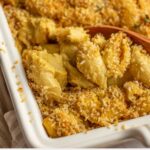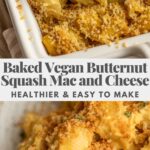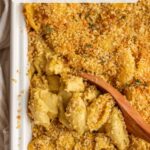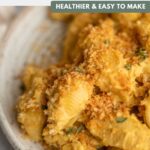Baked Vegan Butternut Squash Mac and Cheese
This baked vegan butternut squash mac and cheese uses a creamy cashew cheese sauce without dairy, coconut milk or vegan cheeses. An indulgent and comforting meal that is easy to make.
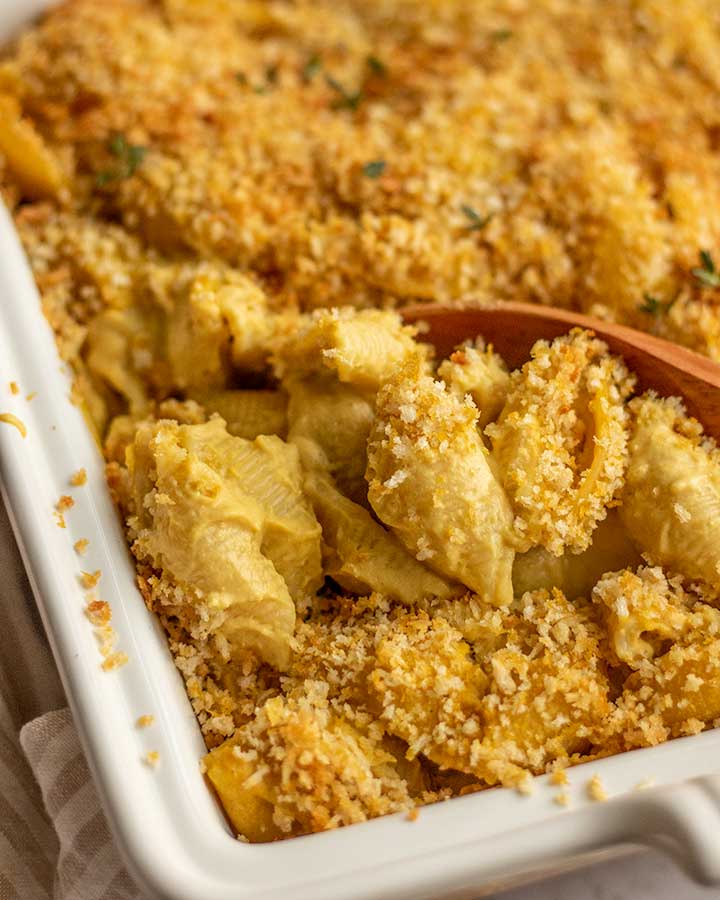
I know what you’re thinking, if it doesn’t have cheese, what makes me think I can call this a mac and cheese sauce? It’s sacrilegious to some, but for those of us in the dairy-free category that also aren’t fans of vegan cheeses that taste like plastic, it’s okay to chase after a sauce that brings back familiar childhood memories and makes your tastebuds happy. Not to mention there are people that also are minding their saturated fat intake for various reasons, I see you! This sauce is for you.
So after I fell in love with my Butternut Squash Orzo, I felt I could use the creamy sauce as a base to add cheesy flavor to. And after a lot of research and playing with ingredients, this sauce made me the happiest.
Why You’ll Love This Butternut Squash Mac and Cheese
- Creamy and indulgent thanks to the combination of blended butternut squash and cashews. Together they make the sauce velvety, which gives the pasta the best texture.
- Cheesy flavor notes without the need for dairy or vegan cheeses thanks to the combination of cashews, nutritional yeast and miso paste.
- Can be made gluten-free by swapping out the pasta and panko for gluten-free varieties you love.

Key Ingredients and Substitutions
- Butternut Squash: While this was the squash I chose, you can make this pasta work with acorn squash, kabocha squash or 1 cup canned squash puree.
- Shallots: If you don’t have shallots, you can also use a small yellow onion.
- Garlic: Whole fresh garlic cloves are needed since we are roasting them. Adding the roasted garlic and butternut squash together makes for an amazing flavor combination.
- Cashews: Use raw unsalted cashews.
- Nutritional Yeast: This adds our cheesy flavor. I would not recommend swapping this ingredient.
- Miso Paste: Helps to add more umami flavor and that light fermented taste (think of that ‘funk’ that cheese has) to the sauce to enhance more of that cheesiness.
- Mustard: I recommend Dijon mustard for a nice tang to the sauce. If you don’t have it, just leave it out and add a little more lemon juice if desired.
- Pasta: Use the pasta shape you love. You can also make this gluten-free by choosing a gluten-free pasta variety you love. Corn, quinoa, or bean based pastas work really well here just make sure not to over cook them.
- Panko Bread Crumbs: I prefer this style of breadcrumb to others for a light and crispy topping. To make this dish gluten-free opt for gluten-free panko bread crumbs.
- Plant Based Milk: For the best result I would recommend using cashew milk. It’s still creamy and doesn’t add a weird sweetness to the sauce like coconut milk can.
- Tapioca Flour/Starch: Since we are not making a roux, using tapioca flour helps in 2 ways. It’s starchy for the thickening aspect, but it also is lighter in taste and doesn’t leave a gritty after feel in the sauce like cornstarch can.
How to Make Vegan Butternut Squash Mac and Cheese
Preheat your oven and add the butternut squash, shallot, and garlic to a lined baking sheet. Drizzle everything with oil, spread it over the cut side of the squash and toss everything else to coat. Season with a generous pinch of salt and top the squash with the thyme sprigs (optional), then flip it over so it is cut side down on the pan. Place the pan in the oven to roast for 20 minutes. Remove the garlic cloves and shallots then roast the squash for an additional 10 minutes or until fork tender.
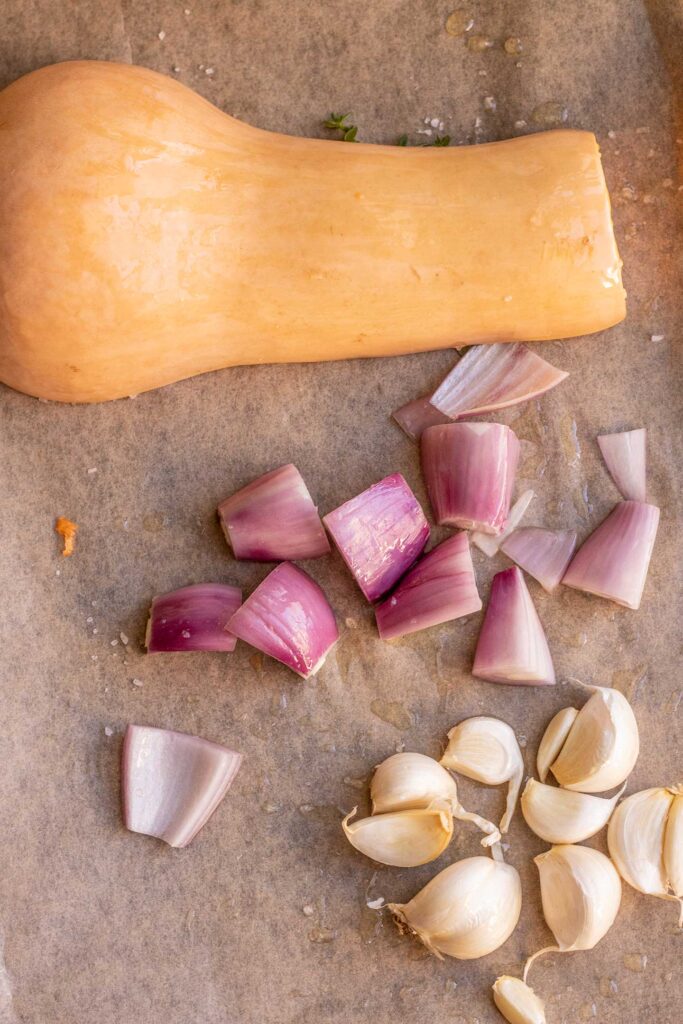

While the squash roasts, add the cashews to a bowl and cover with boiling water. Allow the cashews to soak for at least 15 minutes and drain. Then, bring a large sauce pan with water to a boil and salt generously. Once boiling, add the pasta and cook until al dente according to the instructions of the pasta. Reserve 1/4 cup of the pasta water and drain the pasta and place back in the pot.
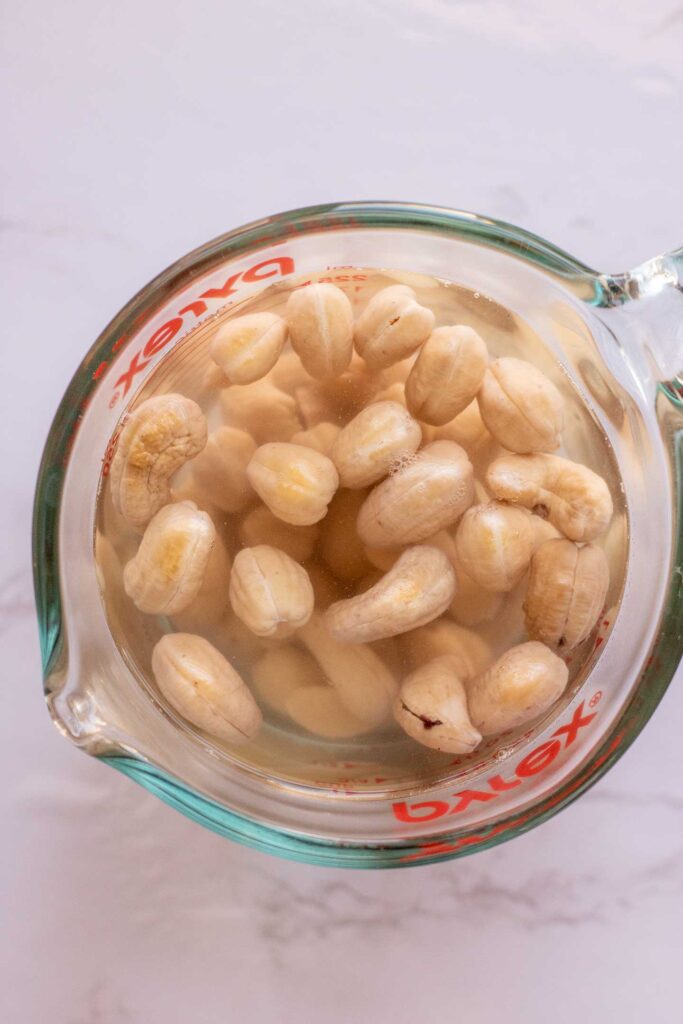

Once the squash is safe enough to handle, scoop out 1 cup of the flesh and add it to a high speed blender along with the drained cashews, garlic, shallots, sage, milk, nutritional yeast, starch, paprika, lemon juice, miso, mustard, 3/4 teaspoon of salt and reserved pasta water. Blend on high until the sauce is creamy.

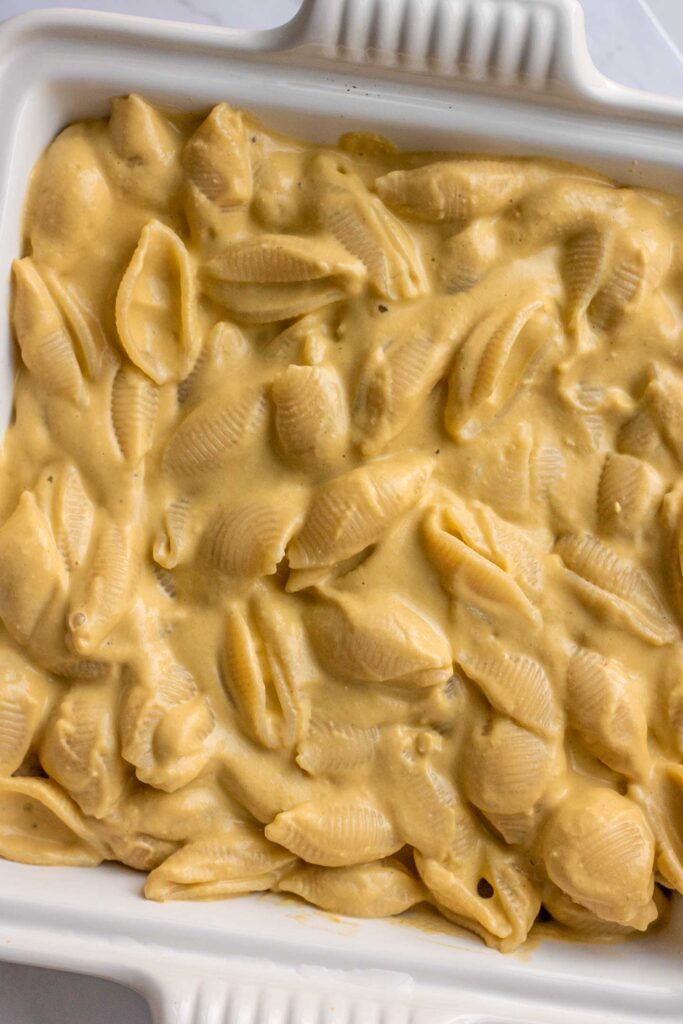
Pour the sauce over the pasta and mix to coat then place into a greased 9-in x 9-in baking dish. Combine the breadcrumb toppings and top the pasta with the mixture. Place back in the oven for 15 minutes or until the crumb topping begins to brown before serving.


Expert Tips
- Salt your pasta water. Remember that this is an opportunity to infuse more flavor into your pasta, so salt it generously.
- Adjust flavors to taste. Taste your sauce. Palates vary and you may find that the sauce needs some extra nutritional yeast, miso or salt. Do note that if you blended in the tapioca starch, you will have some of those starchy notes to the sauce. It will bake off.
- Don’t skip roasting your squash. It adds a richer flavor to the sauce. I don’t like peeling butternut squash so I just roast it in half. But if you have cubed butternut squash, you can roast it in the oven for about 25 minutes until nice and soft.
- Roast extra squash. While I use half a medium squash in the recipe, everyone’s perception of size can vary. To be safe and make sure you have enough squash, just roast both halves. Save leftovers for other recipes.
- If you don’t have a high speed blender, soak your cashews with boiling water from a teakettle for an hour or with cool water overnight. This will help to soften the cashews significantly so they blend easier.

Frequently Asked Questions
Allow the pasta to completely cool and then add it to an airtight container. Seal and store in the fridge for up to 3 days. Do note, the pasta will continue to absorb the sauce, so it will get drier as it sits. To help fix this when reheating, add a serving of pasta to a baking dish along with 2-3 tablespoons of cashew milk and 2 teaspoons of vegan butter. Cover with foil and bake in the oven at 375F for 10 minutes, then remove the foil and bake an extra 5 minutes to completely warm it through.
Yes! Swap the pasta for a gluten-free pasta you love and the panko crumbs for gluten-free panko crumbs. Both alternatives should generally be available under various brands at your local grocery store.
I do not recommend freezing the pasta as this will make it mushy when it thaws. You can however, make the sauce in advance and freeze it in an airtight container for up to 2 months. When ready to use, thaw the sauce in your fridge or on the countertop and use as desired.
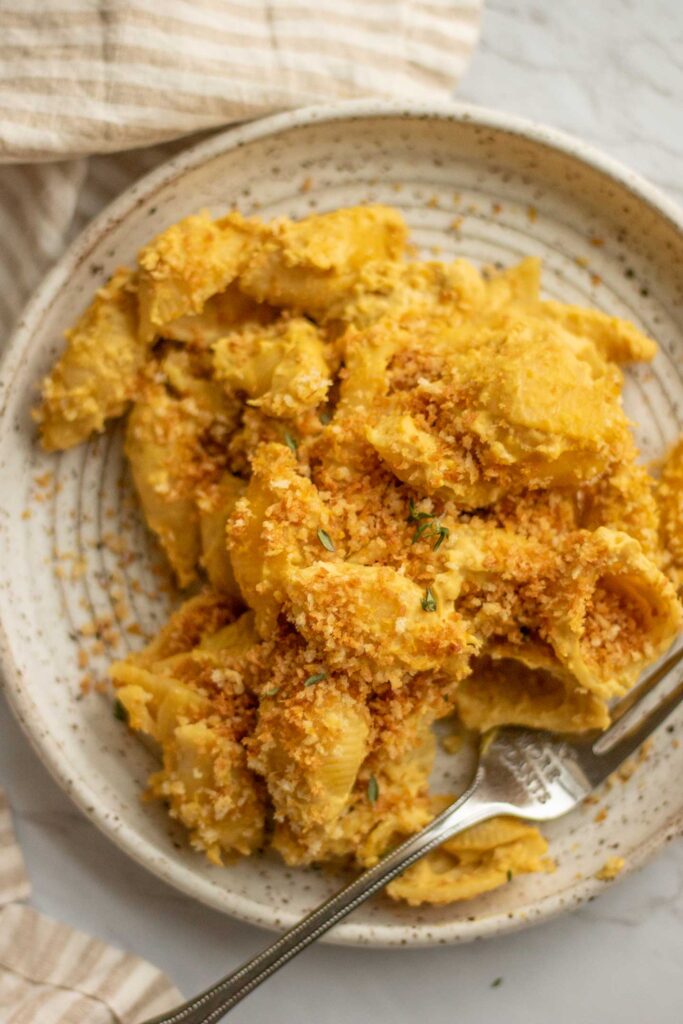
How to Serve
While this vegan butternut squash mac and cheese is filling on it’s own, you may wish to serve this with some other additions depending on how you are feeling.
- Add more veggies: Roast some broccoli or cauliflower and mix it into the pasta with the sauce before topping with the breadcrumbs. This will add extra fiber and nutrients to this dish. Some days I want just pasta and other days I want that pasta with some veggies, so do what works for you!
- Pack it with protein: If you struggle to feel full and satisfied with regular pasta, swap it for some whole wheat pasta or bean based pasta for some more protein. You can also add a side of panko tofu or baked tofu for some additional protein too.
More Vegan Pasta Recipes to Try
- Tahini Pasta
- 20 Minute Green Goddess Pasta Salad
- Creamy Red Pesto Pasta
- Tahini Ranch Pasta Salad with Smoky Tempeh
- Baked Hummus Pasta

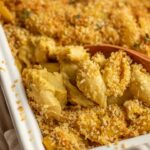
Baked Vegan Butternut Squash Mac and Cheese
- Prep Time: 20 minutes
- Cook Time: 50 minutes
- Total Time: 1 hour 10 minutes
- Yield: 4 servings 1x
- Category: Main Dish
- Method: Baking
- Cuisine: American
- Diet: Vegan
Description
This baked vegan butternut squash mac and cheese uses a creamy cashew cheese sauce without dairy, coconut milk or vegan cheeses. An indulgent and comforting meal that is easy to make.
Ingredients
Ingredients
- 1/2 a medium butternut squash**, seeds removed
- 1 large shallot, quartered
- 8 cloves of garlic with their peels
- 8 sprigs of thyme, optional
- 1/2 cup raw cashews, unsalted
- 12 sage leaves
- 1 cup unsweetened cashew milk
- 1/2 cup nutritional yeast
- 1 1/2 tbsp tapioca starch
- 1/2 tsp smoked paprika
- 1 tbsp lemon juice
- 2 tsp white or yellow miso paste
- 1 tsp dijon mustard
- 8 oz of pasta (I like to use small shells or macaroni)
- Avocado Oil, for roasting
- Kosher salt and pepper to taste
Bread Crumb Topping
- 1/2 cup panko bread crumbs
- 2 tbsp nutritional yeast
- 1 1/2 tbsp oil
Instructions
- Set the oven to 400F. To a parchment lined baking sheet add the butternut squash, shallot, and garlic. Drizzle everything with oil, spread it over the cut side of the squash and toss everything else to coat. Season with a generous pinch of salt and top the squash with the thyme sprigs (optional), then flip it over so it is cut side down on the pan. Place the pan in the oven to roast for 20 minutes. Remove the garlic cloves and shallots then roast the squash for an additional 10 minutes or until fork tender.
- While the squash roasts, add the cashews to a bowl and cover with boiling water. Allow the cashews to soak for at least 15 minutes and drain. Then, bring a large sauce pan with water to a boil and salt generously. Once boiling, add the pasta and cook until al dente according to the instructions of the pasta. Reserve 1/4 cup of the pasta water and drain the pasta and place back in the pot.
- Once the squash is safe enough to handle, scoop out 1 cup of the flesh and add it to a blender along with the drained cashews, garlic, shallots, sage, milk, nutritional yeast, starch, paprika, lemon juice, miso, mustard, 3/4 teaspoon of kosher salt and reserved pasta water. Blend on high until the sauce is creamy.
- Pour the sauce over the pasta and mix to coat then place into a greased 9-in x 9-in baking dish. Combine the breadcrumb topping ingredients and top the pasta with the mixture. Place back in the oven for 15-20 minutes or until the crumb topping is golden before serving.
Notes
Salt your pasta water. Remember that this is an opportunity to infuse more flavor into your pasta, so salt it generously.
Adjust flavors to taste. Taste your sauce. Palates vary and you may find that the sauce needs some extra nutritional yeast, miso or salt. Do note that if you blended in the tapioca starch, you will have some of those starchy notes to the sauce. It will bake off.
Don’t skip roasting your squash. It adds a richer flavor to the sauce. I don’t like peeling butternut squash so I just roast it in half. But if you have cubed butternut squash, you can roast it in the oven for about 25 minutes until nice and soft.
**Roast extra squash. While I use half a medium squash in the recipe, everyone’s perception of size can vary. To be safe and make sure you have enough squash, just roast both halves. Save leftovers for other recipes.
If you don’t have a high speed blender, soak your cashews with boiling water from a teakettle for an hour or with cool water overnight. This will help to soften the cashews significantly so they blend easier.
If you tried this recipe or any other recipe on the blog, then let me know what you thought in the comments below! And if you loved it, don’t forget to rate it too. Feel free to follow on Instagram, Pinterest, and TikTok for the latest nutrition tips and recipe videos.
★ Catherine
This post contains affiliate links which means I will make a small commission if you purchase from those links. I only recommend and share products that I know, trust and personally use myself!


